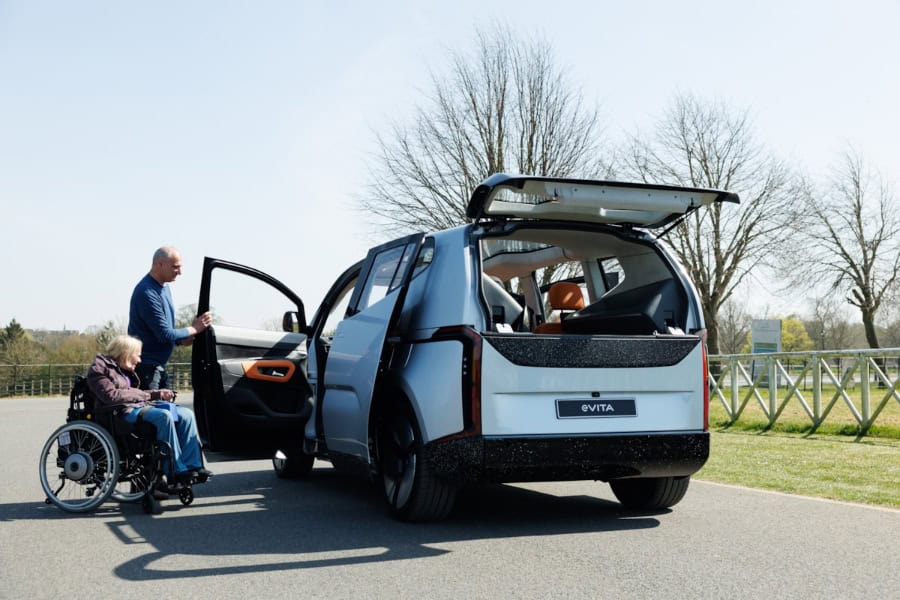Motability Operations has unveiled a pioneering passenger wheelchair-accessible electric demonstrator car to encourage car manufacturers to seize an opportunity to ensure that the transition to electric vehicles does not leave behind wheelchair users.
The car, named eVITA, was designed and assembled in Britain in collaboration with design studio CALLUM, using unique insights from disabled people to address the obstacles wheelchair users face with existing electric vehicles.
Ian Callum CBE, Design Director of CALLUM, said: “Good design should start with understanding people and their real-world needs. Working with Motability Operations on eVITA has been an opportunity to understand what wheelchair users actually need from a vehicle as the industry transitions to electric.
“By taking a collaborative approach, we’ve created something that’s both practical and thoughtful and shows that accessible design doesn’t have to be an afterthought. I hope it encourages others in the industry to think differently and do more.”
Motability says the sector is set to grow sharply in the coming years as the UK and Europe phase out ICE vehicles that would normally be converted into wheelchair accessible vehicles (WAVs). Without innovating to adapt to electric vehicles, up to 1.2 million UK wheelchair users risk being left behind by the transition, it adds.
Motability Operations is harnessing the eVITA programme to engage manufacturers about opportunities for accessible design as the industry shifts to electric.
To ensure that wheelchair users have choice as the sector switches to electric, and manufacturers build in accessibility from the outset of the design process, Motability Operations is sharing the innovative design work with car manufacturers at no cost to enable the production, or conversion, of WAVs.
The business has already collaborated with Kia Corporation on the development of a wheelchair-accessible variant of the PV5, part of Kia’s first Platform Beyond Vehicle (PBV) model. The PV5 WAV variant was on show in the UK for the first time at the FT Future of the Car summit.
Motability Operations continues to work closely with UK converters who have made significant investment in the conversion of electric vehicles. All WAVs on the Motability Scheme have been converted from standard production vehicles by UK businesses that specialise in this work.
Andrew Miller, CEO of Motability Operations, commented: “Up to 1.2 million wheelchair users in the UK are at risk of being left behind as the country shifts to electric vehicles but this can be addressed by placing accessibility at the heart of vehicle design. That is why we invested in eVITA – informed by our customers’ insight – to provide a blueprint for how manufacturers can embed accessibility into design processes from the outset, reducing cost and protecting disabled people’s independence.
“This is just the first step. Our aim is to work with as many manufacturers and converters as possible to share our learnings and support the development of solutions that will safeguard disabled people’s mobility as the industry moves towards electric.”
Disabled people in the UK can access vehicles that provide freedom and independence through the Motability Scheme, which is run by Motability Operations and overseen by the Motability Foundation. This includes leasing WAVs, which allow the individual to travel in their wheelchair. WAVs on the Motability Scheme are produced by converting vehicles, for example, to include ramps or lifts.
The future of electric WAVs has been uncertain due to aspects such as battery placement in EVs limiting access for wheelchair users, says Motability. The rising cost of WAVs, driven by inflation and supply chain disruption, also presents a challenge as manufacturers and converters adapting production-line vehicles face extra costs to ensure electric models are suitable for disabled users.
Motability states that eVITA has shown that if accessibility is considered from the outset, electric vehicles can work for wheelchair users and ensure that no part of society is left behind.
Underpinned by Motability Scheme customer insights and designed including their top priorities, the concept vehicle has new features that make journeys safer, more comfortable, and social.
Key features include a reconfigured battery layout to enable wheelchair access, with a low-angle rear ramp integrated into the electric tailgate; raised windows that reduce motion sickness; a panoramic glass roof that creates more light in the vehicle; and a design that allows wheelchair users to sit closer to the driver, fostering a safer and more social journey.
The shift to EVs presents a unique opportunity to embed accessibility across the entire transition, from vehicle design to public charging infrastructure.
Committed to ensuring disabled people are not left behind in the transition to electric, the Motability Foundation has grant funded extensive research with disabled drivers to understand their vehicle needs and help create further accessible design principles.
Alongside concerns over inclusive vehicle design, 72 percent of Motability Scheme customers expressed worries over the accessibility of the public charging network.
Working to address these barriers, the Motability Foundation partnered with the UK Government to co-sponsor an accessibility standard for public chargepoints, BSI PAS 1899:2022. Continuing to engage with MPs, local authorities, providers, landowners, and manufacturers, the foundation is calling for the standard to be made mandatory.
Nigel Fletcher, CEO of the Motability Foundation, added: “The eVITA demonstrator shows what is possible if accessibility is put at the heart of vehicle design, which will be crucial in ensuring that all disabled people are able to make the transition to an EV.
“At the Motability Foundation we’ve funded extensive research with disabled motorists into the issues they currently face when travelling in their cars and this insight is now being used to create inclusive design principles and concepts that can be applied to standard production vehicles. We will continue to work alongside Motability Operations to drive an inclusive transition to EV.”
The post Call to ensure wheelchair users are not left behind by the transition to electric vehicles appeared first on AT Today – Assistive Technology.

